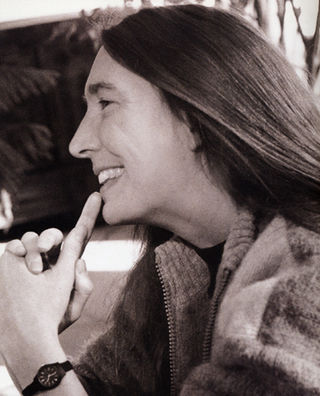
Jenny Holzer is an American neo-conceptual artist, based in Hoosick, New York. The main focus of her work is the delivery of words and ideas in public spaces and includes large-scale installations, advertising billboards, projections on buildings and other structures, and illuminated electronic displays.

The Kitchen is a non-profit, multi-disciplinary avant-garde performance and experimental art institution located at 512 West 19th Street, between Tenth and Eleventh Avenues in the Chelsea neighborhood of Manhattan, New York City. It was founded in Greenwich Village in 1971 by Steina and Woody Vasulka, who were frustrated at the lack of an outlet for video art. The space takes its name from the original location, the kitchen of the Mercer Arts Center which was the only available place for the artists to screen their video pieces. Although first intended as a location for the exhibition of video art, The Kitchen soon expanded its mission to include other forms of art and performance. In 1974, The Kitchen relocated to a building at the corner of Wooster and Broome Streets in SoHo, and incorporated as a not-for-profit arts organization. In 1987 it moved to its current location.

High Performance was a quarterly arts magazine based out of Los Angeles founded in 1978 and published until 1997. Its editorial mission was to provide support and a critical context for new, innovative and unrecognized work in the arts.

The Pueblo Revival style or Santa Fe style is a regional architectural style of the Southwestern United States, which draws its inspiration from Santa Fe de Nuevo México's traditional Pueblo architecture, the Spanish missions, and Territorial Style. The style developed at the beginning of the 20th century and reached its greatest popularity in the 1920s and 1930s, though it is still commonly used for new buildings. Pueblo style architecture is most prevalent in the state of New Mexico, it is often blended with the Territorial Revival architecture.
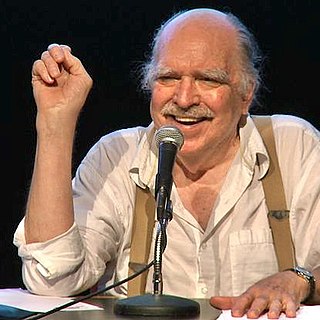
Gene Youngblood was an American theorist of media arts and politics, and a respected scholar in the history and theory of alternative cinemas. His best-known book, Expanded Cinema, was the first to consider video as an art form and has been credited with helping to legitimate the fields of computer art and media arts. He is also known for his pioneering work in the media democracy movement, a subject on which he taught, wrote, and lectured, beginning in 1967.

Steina Vasulka and Woody Vasulka are early pioneers of video art, and have been producing work since the early 1960s. The couple met in the early 1960s and moved to New York City in 1965, where they began showing video art at the Whitney Museum and founded The Kitchen in 1971. Steina and Woody both became Guggenheim fellows: Steina in 1976, and Woody in 1979.

Bohuslav "Woody" Vasulka (born Bohuslav Vašulka was one of the early pioneer video artist known for his solo work and collaboration with Steina Vasulka, his wife. The VASULKAs, as they are sometimes called, were experimenting since early 1960s with images, video tapes, computer graphics and Digital Video Effecter, a technique that was important for television programmes.
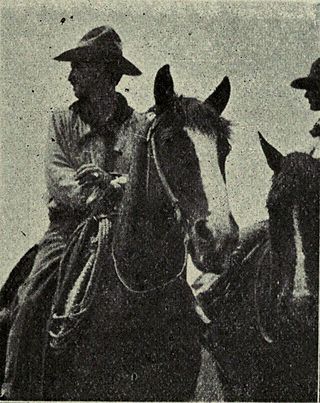
William Penhallow Henderson was an American painter, architect, and furniture designer.

Gerald Cassidy was an early 20th-century artist, muralist, and designer who lived in Santa Fe, New Mexico.
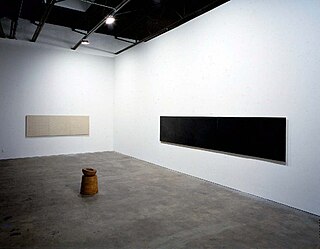
SITE Santa Fe is a nonprofit contemporary arts organization based in Santa Fe, New Mexico. Since its founding in 1995, SITE Santa Fe has presented 11 biennials, more than 90 contemporary art exhibitions, and works by more than 800 artists. Following its presentation of the first international biennial of contemporary art in the U.S., SITE expanded its programming to include ongoing exhibitions of notable artists in solo and group shows, often including new commissions and U.S. debuts. While SITE presents artists from all over the world, it has also provided support and career development opportunities for local New Mexico talent. Approximately 20% of the exhibited artists are based in New Mexico.

Santa Fe is the capital of the U.S. state of New Mexico. The name "Santa Fe" means 'Holy Faith' in Spanish, and the city's full name as founded remains La Villa Real de la Santa Fé de San Francisco de Asís.
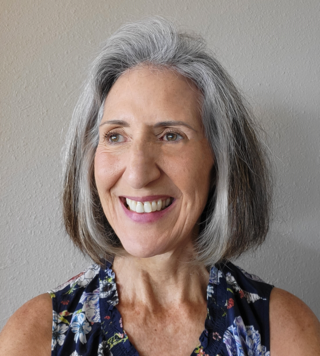
Valerie Martínez is an American poet, writer, educator, arts administrator, consultant, and collaborative artist. She served as the poet laureate of Santa Fe, New Mexico from 2008 to 2010.

Bob Haozous is a Chiricahua Apache sculptor from Santa Fe, New Mexico. He is enrolled in the Fort Sill Apache Tribe.
Kathelin Gray is an American director, writer and curator working across many forms. She has co-founded numerous projects which integrate ecology, science and culture. She writes and speaks on the intersection of art and the sciences.

Eve Andree Laramee is an installation artist whose works explores four primary themes: legacy of the atomic age, history of science, environment and ecology, social conditions. Her interdisciplinary artworks operate at the confluence of art and science. She is currently full professor and chair of the Department of Art and Art History at Pace University. Laramee currently lives in Brooklyn, New York, and Santa Fe, New Mexico. She is also the founder and director of ART/MEDIA for a Nuclear Free Future.

Kathryn High is an American interdisciplinary artist, curator, and scholar known for her work in BioArt, video art and performance art.

Ramona Sakiestewa is a contemporary Hopi Native American artist who lives and works in Santa Fe, New Mexico. Sakiestewa is renowned for her tapestries, works on paper, public art, and architectural installations.

Constance DeJong is a visual artist who works in the margin between sculpture and painting/drawing. Her predominate medium is metal with light as a dominant factor. She is currently working in New Mexico and is a professor of sculpture at the University of New Mexico. DeJong received a National Endowment for the Arts Visual Art Fellowship in 1982. In 2003, she had a retrospective at the Albuquerque Museum of Art and History. That same year, Constance DeJong: Metal was published and released by University of New Mexico Press. Her work has been described by American art critic Dave Hickey as "work worth seeing and thinking about under any circumstances".
Bernadette Vigil is an American artist and illustrator whose work has been exhibited in museums and galleries nationally and abroad. She has produced permanent public artworks in the form of fresco murals for the cities of Santa Fe and Albuquerque, New Mexico. She has been commissioned to create religious frescoes in churches in New Mexico, and has been called a "master of the art of buon fresco" in the Santos Tradition. She has authored a book on Toltec spirituality, Mastery of Awareness: Living the Agreements. In 2002 it was published in Spanish as El Dominio de la Conciencia, and in 2005 it was published in German as Das Geheimnis der vier Versprechen.
Michael David Cook is an American painter and professor. He is an emeritus professor of painting and drawing at the University of New Mexico.


















